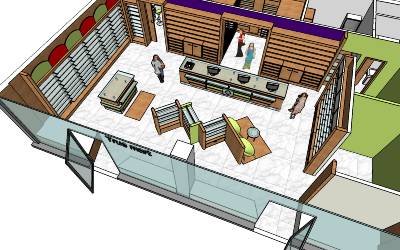<p>It is a sad and sorry fact that starting a retail business can be as much about limiting what you do wrong as maximising what you do right.<br />
So it can make sense to use a professional outfitter to create and implement your retail store layout, leveraging off their experience to avoid common problems.</p>
<h2>1. Plan</h2>
<p>The key to success is always planning well ahead of time before starting anything.<br />
You need to research the competition,<br />
the proposed location of the store, finalise the store concept, and the budget.<br />
More decisions follow: the choice of fittings on the market;<br />
to select specialist equipment or display cases, and<br />
their arrival and installation.<br />
You also need time to select your preferred outfitter – the best are often the busiest.</p>
<h2>2. Hire an Interior Designer</h2>
<p>A professional interior designer can transform a space from being adequate to simply stunning.<br />
Cost is often an issue when opening a new store; the budget can be spent several times over.<br />
But it is well worth tapping into the creativity and experience of a professional designer, even if only for an hour or two of their time.<br />
What an interior designer will give you are personalized, tailor-made solutions that suit your projects, budget and requirements.</p>
<h2>3. Exterior and Interior Congruency</h2>
<p>Your shop front is the defining advertisement for your business. It should reflect your store concept and demonstrate what you are selling.<br />
Signage (both outside and inside the store) and store fittings should be compatible with this store concept and your stock.<br />
If you give an impression of a clean, fresh, fashionable store on the outside then the fit out should be equally clean, fresh and minimalist.</p>
<h2>4. Lighting is Critical</h2>
<p>This is where hiring a good interior designer pays off. Correct lighting can make or break the store’s ambiance.<br />
If you choose not to hire a professional for advice, try a variety of lighting options and positions.<br />
Take pictures of the different set-ups so you can determine which one showcases your merchandise the best.<br />
Colour can be an endlessly debated topic. Don’t be afraid of using it, just don&#8217;t overdo it.</p>
<h2>5. Getting the Right Shopfitter</h2>
<p>When gathering shop fitting quotes, look for a shop fitter who knows your particular business and understands your store concept and purpose.<br />
Is it to rebrand a store? Increase sales and foot traffic? Create sales hot spots?<br />
Or maybe create a more ambient atmosphere so customers linger and stay a while in your store?<br />
If you are looking for a professional shopfitter in Sydney consider TU Projects who have long successful track record there.<br />
Well planned shop fitting is a simple but effective way of attracting customers into your shop.<br />
Good planning can also make use of limited space available, both in the retail and the stockroom areas.<br />
The plan should include adjustable shop shelving to allow flexible display options,<br />
and flat and angled shelving to display different kinds of merchandise, and layout optimized to suit employee workflow<br />
Written by Daniel Lewis. When Daniel isn&#8217;t working for one of the best shopfitters in Australia he likes socializing, meeting new people, and trying new cuisines.</p>

5 Tips For Designing Your Retail Store Layout
